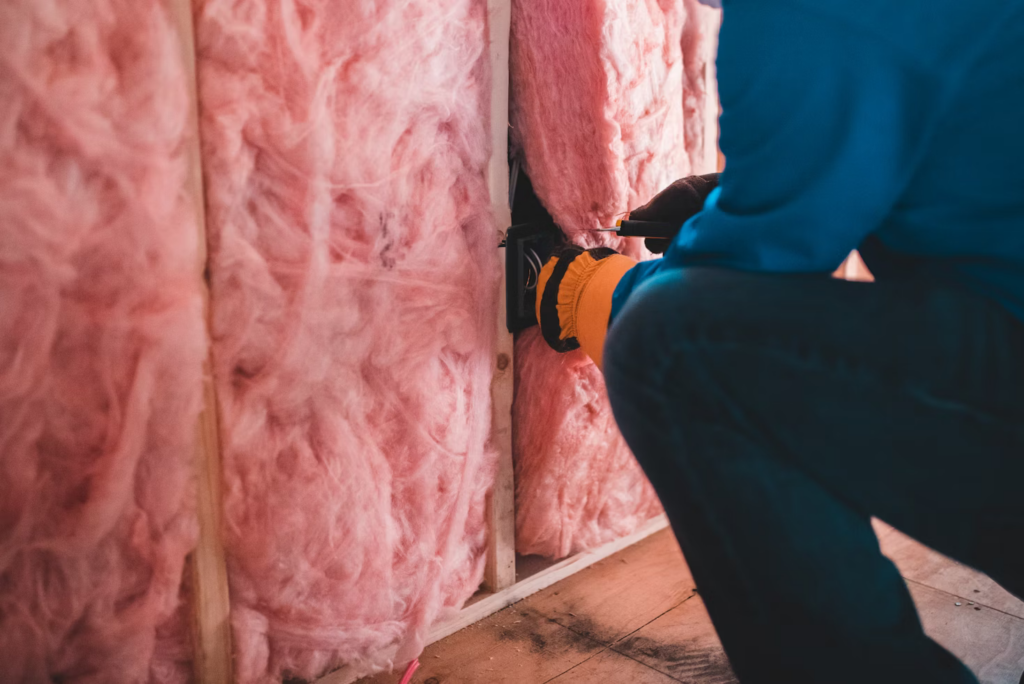Who Cares About Insulation?
If you’ve lived in a bone-chilling country like Canada or Russia you probably already know stuff about insulation. When February pulls up with it’s sub-zero temperatures and wind chill nothing brings a warm smile to people’s faces than some insulation. Precisely, insulation is a thermally-resistant barrier that stops outside temperatures from penetrating your home’s walls. In addition, it locks the inside temperatures from going outside of your house to keep you comfy all year round. It is measured by R-value. Locations like your basement and attic need higher R-values to insulate them better compared to other parts of your house.
The Insulation Warmup Routine
Get your house properly ventilated. Why? Not doing so will lock in too much heat and condensation, causing it to build up. In addition, you’re going to need that fresh air while you get your insulation done. You also want to plug leaks to keep air from getting in and out around windows and doors. If you do the rest of your insulation before plugging these, you’ll finding yourself looking for a needle in a haystack. You’ll be on a tough assignment, fam.

The Insulation Starter Pack
What do the following have in common?
- a tape measure
- a utility knife
- a straight edge
- lightweight stapler or hammer tacker to secure your insulation in place
- a putty knife
If you’re reading this and thinking “these are the glorious tools to stay warm” then you are on the money. These bad boys will all be used to get your insulation done and get your crib feeling nice and warm. Beyond the items listed above, there’s some extra items you can collect to give your roster a deep bench when the starting line up needs a breather:
- drywall compound
- expanding foam sealer
- a portable light if working in attics/crawl spaces
- plywood to stand on
- a rake to adjust your insulation
- insulation supports
Safety Tips for Insulating Like a Boss
We’re all trying to stay warm, but we’re not filming “Get Warm or Die Trying”. Stay safe by juking these insulation hazards:
- itching
- skin irritation
On game day you won’t be caught slipping if you wear these following items to dodge the hazards listed above:
- long sleeve shirts
- pants that go down to your ankles
- shoes to cover your feet
- work gloves
- safety glasses
- a dust mask or respirator to avoid irritating your skin or breathing in harmful substances
You’ll need to vacuum your clothes immediately after you’re done insulating stuff to avoid skin irritation.
How Do I Pick my Insulation Material?
The most common types of insulation are fibreglass, cellulose, and foam. However, there’s no such thing as insulation material that are a one-type-insulates-all. Here’s how you can decide which insulation material you need:
- where are you insulating
- how much more insulation R-value do you need?
- what type of insulation will you need?
- how much insulation will you need?
- will you do-it-yourself (DIY) or hire a professional to do it?
Firstly, In terms of insulation the most effective places for it are in the attic, basement walls, and crawl spaces. Secondly, you’ll need to know how much more R-value you’ll need for your insulation. The R-value measures measures how good different insulation materials resist heat. The higher it is the better. On the contrary, its value drops if the insulation becomes compressed. The right value depends on a few factors, such as:
- your geographic region, province, or state
- what city you’re in
- what part of your house it is, such as your floors, ceiling, or walls
For example, if you live in Ontario there is a chart below that shows you the exact R-value you’ll need in each space of your home to stay coolin’ in the summer and to stay heated in the winter.
| Decent | Exceptional | Heavenly | |
|---|---|---|---|
| Ceiling With Attic Space | R-60 Batt or Blown Insulation | R-70 Batt or Blown Insulation | R-80 Batt or Blown Insulation |
| Ceiling Without Attic Space | R-31 Batt Insulation | R-35 Batt Insulation | R-35 Batt Insulation + R-5 CodeBord® |
| Exposed Floors | R-35 Batt Insulation | R-35 Batt Insulation + R-5 CodeBord® | R-35 Batt Insulation + R-10 CodeBord® |
| Walls Above Grade | R-22 or R-19 Batt Insulation + R-5 CodeBord® | R-22 Batt Insulation + R-5/7.5 CodeBord® | R-24 Batt Insulation + R-10 CodeBord® |
| Basement Walls | R-15 or R-20 Batt Insulation + Blanket Wrap | R-14 Batt Insulation + R-10 CodeBord® | R-24 Batt Insulation + R-10 CodeBord® |
Insulation Material Types
Insulation is available in many forms depending on the location & R-value.
Fibreglass Insulation vs. Cellulose Insulation
Fibreglass and cellulose insulation share a similar R-value, but are different in terms of where they’re installed, their suitable climate, and other factors.
Fibreglass Insulation
Fibreglass is fire-resistant and can be used in batts or as a blown-in insulation. It’s budget-friendly compared to cellulose and can lose it’s R-value when compressed. It’s installed in extreme-cold situations. If it’s installed in batts you’ll be caught slipping if you leave gaps or holes. Why? This will reduce its effectiveness.
Cellulose Insulation
Cellulose insulation is that thick, paper-based product that’s always blown-in. Compared to fibreglass insulation:
- its R-value is not affected by compression and degradation
- it’s better in extreme cold situations
- fills wall cavities better
- more environmentally friendly
Blown-in Insulation and Loose Fill
Blown-in insulation or loose fill is usually made of fibreglass or cellulose (recycle paper fibre). It is blown or sprayed into place with a machine. It’s perfect if you need to use it in hard-to-reach areas, such as wall cavities. You can use it to top up your existing insulation. If you install it yourself you can cop a blowing machine to get the job done.
Batts
Unlike baseball, batts are pre-cut sections of fibreglass or rock wool insulation. They’re designed for easy handling and use between framing. People use these in floors, walls, attics and ceilings.
Foam Board
Foam board, or rigid panels of insulation, can insulate almost any part of your home. The most commons materials used to make it are p olystyrene (also known as styrofoam insulation) and polyurethane. Foam board insulation sheathing reduces heat conduction through structural elements like wood and steel studs.

Spray Foam
Spray foam comes in the form of latex or polyurethane. It’s used to fill small gaps and cracks. If you have annoying windows and doors that let cold air and wind in this is the insulation material you need. It sets quickly and can be trimmed, painted, or stained. If you’re going to cover it with larger areas you’ll need special equipment. Hopefully not a SWAT team level of special equipment.
Vapour Barriers
Vapour barriers are a type of plastic (polyethylene film) that is applied on top of the insulation inside stud-framed walls. It helps you control how much moisture passes through your insulation. It’s commonly used to frame a house’s exterior walls. Be aware of moisture from either direction building up within the stud or cavity walls. This is because heat-conducting moisture cause insulation to lose its R-value and also allow mold and rot to set in over time.
Radiant Barriers
Radiant barriers deflect radiant heat and can pass through other types of insulation to increase your home energy efficiency.
Time to Calculate Your Insulation Costs
Calculating how much guap you’ll drop on keeping your crib warm comes down to four simple steps:
- Checking to see if your house is already insulated. You’ll need to know the insulation type and compare it to industry standards for R-value.
- Calculate your extra insulation needs. For example, if the industry standard insulation R-value is R-50 and your depth is less than this you can find your top-up amount by subtracting your R-value depth from 50.
- Top-up amount = [your R-value depth] – 50 (the example industry-standard R-value)
- You’ll need to measure the area you’ll be insulating. This is because insulation batts usually come in 16- or 24-inch widths to fit spaces between walls & attic frames.
- You need to figure out which insulation type you’ll be using. People that make insulation cut batts into 4-foot lengths. To figure out how much insulation simply divide your total from step 3 by the square footage per bag. Then find the insulation cost and multiply one unit by the total you need to complete the job.
Summary
Insulation’s pretty good at keeping people warm. Not only when you’re looking to keep the cold out, but also when you’re looking to keep the heat out. What insulation materials are in your insulation roster? How long have you had them for? Are they fire-proof? Where in your house did you use them?
Leave a comment below with your answer and don’t forget to share the content!


